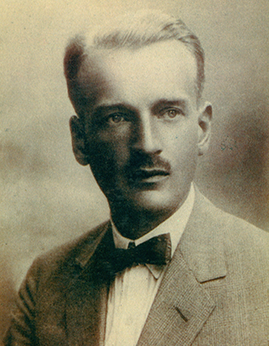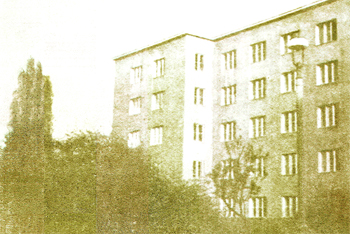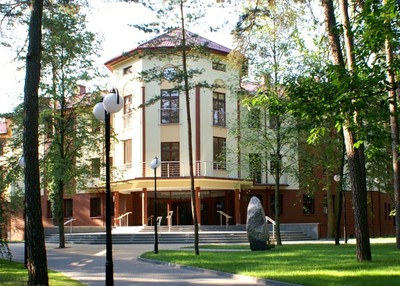This website uses cookies so that we can provide you with the best user experience possible. Cookie information is stored in your browser and performs functions such as recognising you when you return to our website and helping our team to understand which sections of the website you find most interesting and useful.

Short history of the IBL

In the mid-twenties of the 20th century when Poland gained its independence after the First World War, Polish foresters took a decision about creating a scientific unit which would carry out forestry-related experiments. This undertaking became successful in 1930 when the Experimental Unit of the State Forests was established. Right after the Second World War the Unit obtained its present name, which widened the range of studied topics to the whole forestry science and covering all Polish forests. The research conducted by the Institute from the beginning of the institute’s activity was centered on enrichment of knowledge necessary for conducting forest management. The basement for that knowledge, similar to all natural sciences, is formed by experience, experiment, and observation. By the nature of forestry activities, such research is long-term, complex and at the same time it is quite heterogeneous due to the richness and variability of forest ecosystems and also the possibility of forming by humans different structures of forest management according to social potentiality and needs towards forest. Owing to the gathered through experiments observations and empirical data as well as based on the induction generalizations, the theories could be formed which could explain processes occurring in the forest and help to define the principles of forest management. With advancement of science, those theories become more universal and accurate, while management principles become more specific. Thereby, the pragmatic role of the research conducted by the Institute is growing.

In the beginning of its activity, the research conducted by the Institute concentrated on intensification of forest management in order to increase forest productivity, to secure wood resources and to rationalize its use. Such research direction was linked to the threatening deficit of raw timber due to the low forest cover in the country, due to the devastation of forests by occupants during the First World War as well as constantly growing demand for timber. In such situation, it was important to concentrate the research on good selection of seeds and seedlings coming from highly productive forest ecosystems and also to limit the destructive impact of forest pests and fungal diseases. At that time, the Institute also played the pioneering role in the area of nature conservation and protection of endangered plant and animal species.
During the interwar era, the Institute took up the honorary place in science, although it was functioning just for a short period. The Institute also had a significant influence on forest management. It established multiple contacts and started cooperation with national and international forest science organizations and also became an active member of the IUFRO founded in the end of the 19th century.
The Second World War and period of occupation were very painful also for the Institute and its staff. Seventeen of its employees were killed during the war, and the Director Jan Hausbrandt was murdered in Katyń. The property of the Institute was devastated, while collection and databases were stolen or destroyed. Along with the formation of forestry administration after the end of the war, the Institute gradually restarted its activity. In November 1944, the newly appointed
Director Franciszek Krzysik gathered the researchers, secured the property and research areas, started the work of the Seed Evaluation Station headed by St. Tyszkiewicz in the Drewnica Forest District, and also established the branch of the Institute in Białowieża headed by Jan J. Karpiński. From January 1946 the residence of the Institute was again in Warsaw. The former employees have returned and new engineers and researchers were appointed.
After the World War II, reconstruction of forest management and afforestation of unused agricultural lands on the large newly annexed areas became the priority for the State Forests. At that time, the Institute conducted pioneering work on scientific and practical principles of forest management for such needs. The research done at the Institute facilitated diagnostics of site conditions and agricultural soils of different categories, established methods improving growth conditions for trees, defined the most proper techniques of soil preparation and land improvement, fostered selection of suitable tree species, offered methods of forest protection and management. The Research Institute of the State Forests was renamed into the Forest Research Institute, and from March 1946 it came under the Minister of Forestry obtaining legal entity status from 1951. The structure of the Institute has changed many times with new departments and laboratories being added, and new research groups responsible for contemporary research and new scopes of tasks for the State Forests being created. The disciplines and areas, which would assist in improving forest productivity, effectiveness of harvesting and protection of raw timber, were becoming more and more significant. The Institute evolved research programmes in the areas of forest economics, organization of forest management, timber harvesting and transportation, management in mountain forests, soil science and fertilization, forest microbiology and ecology.
Parallel with the analysis related to timber harvesting, skidding and protection, the Institute conducted prospective research into forest sustainability. It included development of the new forest site classification, which set the bases for management activities in forestry. The Institute elaborated new methods of stabilization and afforestation of unused agricultural lands, defined principles of seed tree selection, classification of seeds and cones, prepared annual reports on seed yield of the most important forest trees and shrubs, and also conducted wide research on the topic of water management in forests.
In the 1960s poplar plantation were seen by the State Forests as new and attractive source of raw timber for cellulose and paper production. The research into management and health of poplar cultivars allowed conducting the inventory of poplar plantations, developing the guidelines on plantation establishement, methods of production, tending and protection of trees in more than 60 newly created plantations. The research also indicated poplar varieties which were unsuitable for planting in Polish conditions due to their health state. The Institute made a significant input into the development of forest management science in the area of forest protection, which was started in 1930s. It included such disciplines of forest protection as entomology, phytopathology, protection against forest fires, protection from pests and nature conservation. In 1950-70s, the Institute prepared the monographic study on biology and ecology of the most significant forest insect species and methods of their forecasting. There was developed and introduced the annual national autumn inventory of forest pests with preparation of signalling maps, which allowed evaluation and forecasting of pest danger. Chemical pest control methods were tested along with the introduction of new biological techniques of forest protection. The IBL elaborated complex fire protection method, which exemplifies comprehensive understanding of forest as ecosystem and uses mechanisms of its functioning for limiting the number of pests using means natural for the environment.
The work conducted by the Institute in 1970s and 1980s to a great extent was ruled by the command economy of the State Forests, the need to ensure regular wood supply to the industry and to care for the adequate health state of forest stands. At the same time, the Institute also carried out the research intended to develop the scientific bases for the improvement of stand resistance using various silvicultural techniques, taking advantage of myco- and bacteriotrophical processes as well as artificial mycorrhization of seedlings, fertilization of trees in nurseries and in weakened stands, or selection of poplar and willow varieties passive towards pathogens. Such research inspired new projects on prevention and therapy with the effects leading to direct introduction of research results into forest practice. Many methods developed as the result of such research were updated and are still being used. As an example, it could be mention the modern system evaluating fire danger, new methods of protection against game, ecological techniques of monitoring and protection from insect pests, or „PgIBL” mixture for the protection against root rot. Research results developed by the Institute and their efficient introduction into forest practice allowed improving the health and resistance of forest stands, increasing the stability and sustainability of forest ecosystems and maintaining forest biodiversity.
In the second half of 1970s, the Institute leaded by Zygmunt Patalas expanded its laboratories and infrastructure, established international contacts and exchange with partner institutes. It conducted multiple research projects on forest productivity, studying technological or organizational problems, which were considered important from the point of view of the State Forests. Many other scientific achievements of the Institute in the areas of forest protection, silviculture, animal ecology, hunting, forest policy and economics, optimization of organizational structures and forest management in general could also be given special consideration.
The year 1990, when Andrzej Klocek was nominated for the Director, became a turning point for the Institute. The new director had large contribution to a wide-ranging development of the IBL, its scientific and organizational successes. The Institute opened the 4-year Doctorate Studies (the 3rd edition is currently ongoing), the Winter Forest School, and also annual 3-months long scientific practices for 3-4 young researchers from the neighbouring Eastern countries. The Institute upgraded its equipment base, which allowed it conducting high quality contemporary research.
The researchers of the Institute have developed many new theories covering the numerous topics. Some examples include the principles of forest pathology (Witold Koehler), the theory of industrial climax (Janusz Wolak), ecological sylviculture basis (Zygmunt Obmiński), the concept of utilizing phytosociological methods in forest planning activities (Aleksander Sokołowski), the framework of the National Programme of Extension of Forest Cover (Bogdan Łonkiewicz and others), as well as the implementation landscape afforestation programme (Kazimierz Zajączkowski), the conditions of wood price designation and costs of wood production optimization were estimated as well as the ground and tree stands values of forest divisions were determined in Forest State Organization (Tadeusz Partyka), the conception of biological forest protection against root rot using the bio-technology of Phlebiopsis gigantea fungi (Kazimierz Rykowski, Zbigniew Sierota), as well as the bases for using pheromones and kairomones in the protection of trees against insect pests (Andrzej Kolk). The Institute became the place for the scientific discussions on the topics of pro-ecological forest management (Kazimierz Rykowski), the use of sylvicultural methods on agricultural lands (Jan Zajączkowski), protection of forest genetic resources (Stanisław Tyszkiewicz, Stefan Kocięcki, Jan Matras), or forest watersheds (Feliks Białkiewicz, Jan Tyszka, Edward Pierzgalski). The Institute has worked out assumptions of the national forest policy, the criteria of the sustainable multifunctional forest management, the issues of forest protection in Europe, and bases of the national forest programme (Andrzej Klocek, Kazimierz Rykowski and others). The IBL conducted the research and analysis on die-off of forests in Sudety mountains and proposed the action strategy to the State Forests (Andrzej Gorzelak and others), the research on die-off of oak stands in 1980th (Jan Zajączkowski, Czesława Kozłowska, Andrzej Kolk), developed the programme of protection of forest genetic resources (Stefan Kocięcki, Andrzej Załęski, Jan Matras, Adam Korczyk), the programme for forest watersheds (Stefan Ostrowski, Feliks Białkiewicz, Jan Tyszka, Edward Pierzgalski). The Institute was the author and coordinator of the technical forest monitoring programme (Janusz Wolak, Janusz Olszowski, Eryk Latocha), the biological forest monitoring (Stanisław Dunikowski, Jerzy Wawrzoniak, Józef Wójcik), the methods of inventorying of size and structure as well as productivity of forest resources and forecast of their development (Jan Głaz, Andrzej Klocek), the environmental research in the Białowieża Forest and other old-growth forests of the north-eastern part of the country (Aleksander Sokołowski, Simona Kossak). The researchers of the Institute developed multiple research programmes for forest areas damaged by catastrophic events, including those damaged by nun moth (Lymantria monacha) in 1970-80s (Barbara Głowacka), by forest fires in 1992 (Tytus Karlikowski, Eleonora Szukiel, Józef Zwoliński), by the flood in the Odra river valley in 1997 (Andrzej Gorzelak, Zbigniew Sierota), by snow- and windbreaks in the mountains (Jan Zajączkowski, Zenon Capecki), after the wide insect spread of various species (Edmund Śliwa, Jerzy Burzyński, Zbigniew Sierpiński, Andrzej Kolk, Barbara Głowacka, Zenon Capecki), or by the huge windthrow at the Szast area of the Pisz Forest (Kazimierz Rykowski).
From the beginning of its 80-year long activity, the Institute was developing its scientific cooperation on the international level starting with the study trips of J. Hausbrandt and participation of St. Tyszkiewicz in forest selection research before the war. The cooperation continued within the frameworks of the IUFRO and FAO, through bi- and multilateral contacts with partner institutions of the IBL in Eastern and Western Europe as well as currently being developed within the Framework Programme of the European Union starting with its 4th edition. The IBL has received the status of the PROFOREST Centre of Excellence (CoE) in the area of protection of forest ecosystems. During the last several years, the Institute participated in 31 international actions and research programmes.
The human potential of the Institute, its certificated laboratories and modern equipment serve the society and science through implementation of research and applied projects. The projects come on request of the Ministry of the Environment, the State Forests, the National Fund for Environmental Protection and Water Management as well as Ministry of Science and Higher Education on the base of competition, which allows also to develop own conceptions and hypothesis with high practical usefulness.
Prepared by:
Maria Gozdalik (period 1930-1939)
Zbigniew Sierota (period 1939-2010)

















